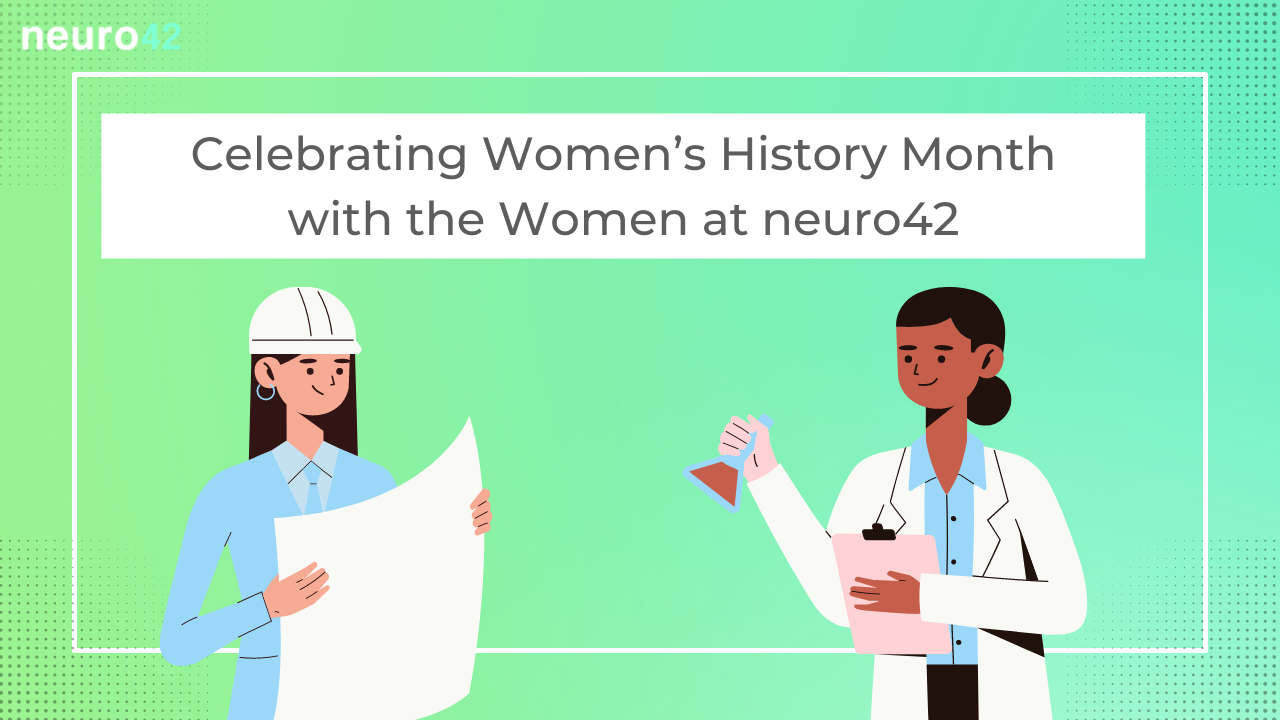Celebrating Women’s History Month with the Women at neuro42

Harriet Beecher Stowe may have put it best when she said, “Women are the real architects of society.” Stowe, an American author and revolutionary who bravely advocated for the end of slavery and increased rights for women, sadly died before some of the things she fought so valiantly for came to fruition. Still celebrated today for the many contributions she made in fighting for equality and inclusion, Stowe’s life ended in 1896—about 100 years before Congress would officially pass legislation recognizing March as Women’s History Month.
The observance of women’s contributions to society began at a local level in Sonoma, California, in 1978. After the idea spread to other local communities, then-President Jimmy Carter declared the week of March 8 National Women’s History Week. The outpouring of support for the cause continued to rise until Congress made the month-long celebration official in 1987.

This year’s theme for Women’s History Month is “Women Providing Healing, Promoting Hope”—a mantra that really resonates with all of us at neuro42. As a medical technology company focused on diagnostic imaging and image-guided surgical interventions of the brain, our hope is that neuro42’s technology can allow for easy access to MR imaging for screening, diagnosis and interventions of neurological diseases.
In essence, we think we can provide healing and promote hope.
We wanted to do our part in celebrating Women’s History Month by introducing you to six women on the neuro42 team who are breaking down barriers in a largely male-dominated field. We asked Nguyên Phạm (Electrical Engineer), Sree Poojitha Yerramsetti (RF Engineer), Ghoncheh Amouzandeh (MRI Scientist), Juan Liu (MRI Scientist), Xiaowei Zou (MRI Scientist) and Joyce Ye (Software Engineer) about topics like working at neuro42 and the challenges of being a woman in a STEM-related industry, and we proudly salute these women (and all women) for their contributions to this field and beyond.

How would you describe your role at neuro42?
Nguyên: I’m responsible for designing, building, testing and troubleshooting printed circuit boards. I also resolve issues with the system’s hardware components.
Sree: My role mainly emphasizes construction of RF coils—a very important part of the system—which acts like an antenna to transmit and receive the signals.
Ghoncheh: I work on development of clinically relevant MR techniques, such as pulse sequence, image processing and reconstruction. I gather technical data through experiments, simulation and formal verification and generate technical reports to support a regulatory submission.
Juan: I develop MRI reconstruction pipelines and collaborate with RF/gradient engineers, pulse sequence designers, and system engineers to implement signal/image processing to generate high-quality clinical MRI images.
Xiaowei: I develop customized pulse sequences and advanced reconstruction algorithms, and help with everything MRI-related.
Joyce: As a software developer, my main job is to design, construct, implement and test end-user applications. I need to develop efficient functions based on requirements. I am also working on the troubleshooting, maintenance and improvement of existing software systems.
What led you to work at neuro42?
Nguyên: I found neuro42’s mission in medical devices and MRI to be innovative, creative and extremely helpful to each American in getting the health care they deserve. That’s why I chose neuro42.
Sree: I was intrigued by the vision of neuro42—to have a portable, lightweight MRI scanner next to the patient and also aiming toward robotic intervention. Being one of the first employees, I was ready to dive in and learn all about the design and strategy, and loved building the whole system from the start.
Ghoncheh: I was fascinated by the idea of building a portable low-field MRI with the addition of robotic interventions for neurological surgeries and wanted to contribute to its development.
Juan: Ultra-low-field MRI could make the MRI technology more accessible and more affordable. I am extremely excited to join such an innovative and passionate team and address challenging technical problems, grow within the company by learning new skills, and work hard to reach our goals.
Joyce: I have great interest in the medical field. Every year, millions of people pass away because they don’t receive prompt aid. I wanted to be part of an organization like neuro42 that really helped save people’s lives. neuro42 is a company which has great respect for women, and I experience a family-like feeling when collaborating with my colleagues.
What would you say to a young woman interested in pursuing a STEM-related career?
Nguyên: I’d say ‘go for it’, because it’s worth every effort and interest you have in it. There will be challenges and difficulties of their own, but you will not regret choosing to be a woman in STEM.
Sree:The true interest within could let you reach heights you never imagined. The hard work will definitely pay off.
Ghoncheh: I’d say you should not underestimate your capabilities in being successful in STEM-related fields. You need to practice working hard and have perseverance, smart learning and time management.
Juan: DO IT! STEM fields are great fun. But it is also very competitive. Lots of women have a successful career in STEM and you must believe you can make it!
Xiaowei: It is fun to pursue a STEM-related career and women are as qualified as men if not more. So if you are interested, go for it. Learn as much as you can and grow as fast as you can. Ignore those who discourage and find those who support you, and keep moving forward.
Joyce: Nowadays, more and more women become engineers and scientists. I really think it's a great thing even though I know the field is full of competition. I think my most crucial suggestion to all young women is to always keep learning new things and always be confident.

Why is it important for women to receive more leadership opportunities?
Nguyên: It’s been proven that women are more than capable of being an excellent leader. However, there are still parts of this world that doubt our talents and abilities. That’s why more leadership opportunities are crucial to change perception, improve equality and amplify women’s influence to many other generations.
Sree: To give them a voice and the confidence that comes through it.
Ghoncheh: Having women in leadership positions allows them to serve as role models that are not only critical for career advancement but stands to generate broader societal impacts on pay equality. This can change workplace policies in ways that benefit both men and women, attracting a more diverse workforce.
Juan: Most changes in the world are led by men. Women can bring different perspectives and a more diverse workplace, which could improve communication, collaboration, and creativity.
Xiaowei: Why not? The world has been dominated by male leaders and we can safely say that many of them have performed poorly. Time to search for alternatives and let whoever is competent lead.
Joyce: I think women leaders are usually less authoritative and more cooperative, which can bring a family-like feel to the entire team. Also, men and women may think of the same problem in different ways, which is very important for the diversity of decision-making, and can provide a more comprehensive and optimal solution.
What challenges did you face as a woman in STEM?
Nguyên: One of the challenges I faced when I first pursued engineering was lack of confidence. When I attended classes that were all male-dominated, I wasn’t sure whether I could fit in or compete against my peers. I questioned my knowledge and abilities. It truly was a journey for me to believe in myself that engineering is the career I always wanted to pursue.
Sree: Sometimes people just assume you can't do the heavy and hard work like men, but you always need to give someone an opportunity to see what they are capable of.
Juan: I’m often surrounded by men and need to compete and collaborate with men. I always work hard and maintain a good work performance.
Xiaowei: When I was a child, I was told that boys were genetically better than girls in STEM. When I scored higher than boys in STEM courses, I was told that girls matured earlier and boys would catch up later. When I went to the best university of my home country and majored in STEM, I was told that girls were just better at tests and boys had real talent. When I got a scholarship from a PhD program at an Ivy League university, I was told that I was the third type of person in the world - female, male, and female PhD. One person even told me that my job wasn't good and that I would be better off to marry someone rich like him. But here I am, healthy, safe, and happy, against all their prophecies. Be good at what you do and work with people who support you. Then relax, enjoy the ride and have fun.
Joyce: I think one challenge is that sometimes we are unconfident and afraid to speak up. We might be a little shy or afraid to share our opinions in front of audiences. Also, sometimes we don't have enough mentorship to seek help. The fact is that there are more men than women working in the STEM field, so we may not be able to find plenty of role models on how to succeed in a STEM career. Also, we cannot ignore that there still is gender discrimination related to hiring, promotion, and salary in women's daily work.
Who are the women you most admire and why?
Nguyên: There are so many women that have influenced me, but I’d love to talk about one that might not get enough attention, Katherine Johnson. She was an extraordinary mathematician at NASA, using her exceptional computation skills in both Project Mercury and Apollo 11. Her assertiveness inspired me to be more confident and encouraged me to keep pursuing engineering.
Sree: I don't admire just one woman, I admire a lot of them for their different qualities. Juan: My mom. My mom used to work extremely hard to support the whole family. She is always optimistic and never complains about the hardships of life.
Xiaowei: I admire all the women who are strong and kind, who lead their own life and help people when they can.
Joyce: I admire Marie Curie. I read her story when I was in primary school, and I still remember feeling impressed by her intelligence and persistence. At that moment, I wished I could be a woman who could spare no effort to pursue the field I love and the things I treasure.
What do you hope for the future for women in STEM?
Nguyên: I hope to see more women joining STEM-related careers to bridge the large gender gap, especially in engineering and computer science fields. It’s not going to be an easily surmountable problem as current society has not promoted women’s intelligence, ambitions and leadership ability enough. I hope to see that change soon in the future.
Sree: I hope we can hear more names and achievements of women in the fields that people don’t even think a woman can pursue.
Ghoncheh: I hope in the future there will be equal opportunities and representation for both women and men in STEM.
Juan: I would like for women to believe in themselves and that they can do extremely well in STEM.
Xiaowei: I hope that my generation will help the next generation of women in STEM to have more support and resources to pursue their passion. I hope this cycle continues through generations so that, little by little, we can change the world for the better.
Joyce: I think the future of women in STEM is bright. Now, more and more women are pursuing a STEM-related career, and the gender discrimination is reducing. I hope in the near future there will be no disparity of gender in STEM and that all are treated equally.

